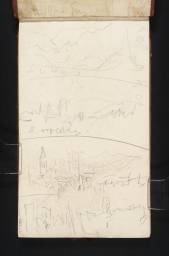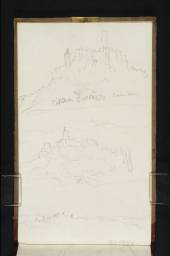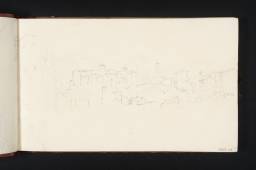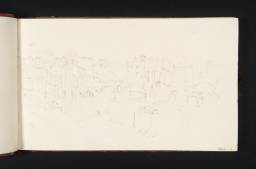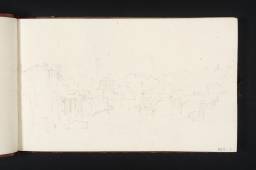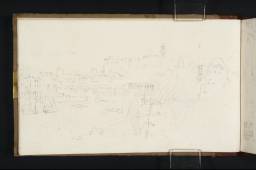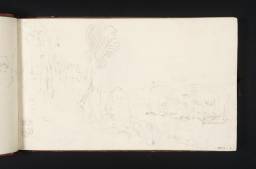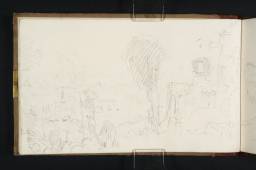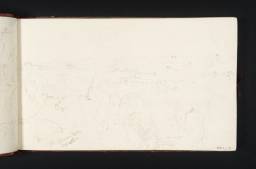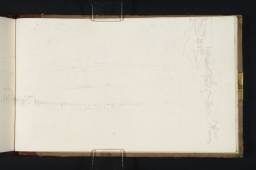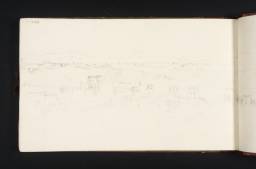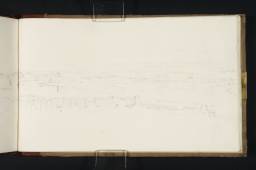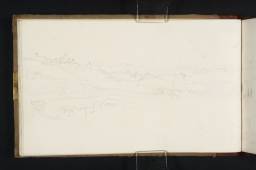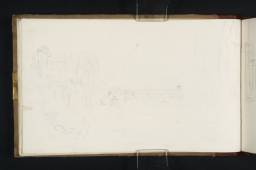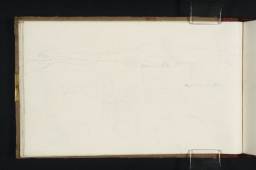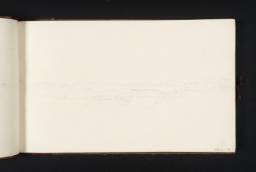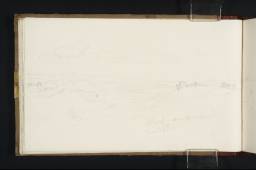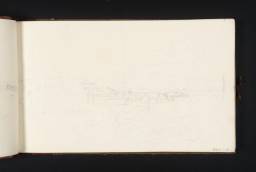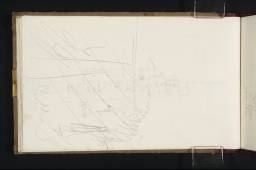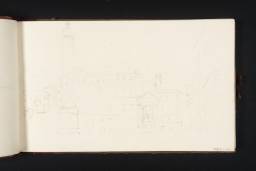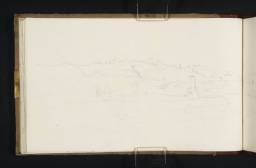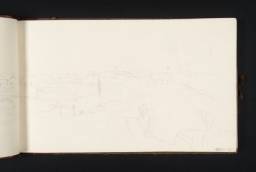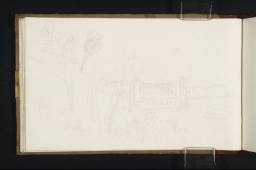Turner Bequest CXCI
Sketchbook with paper covered boards bound with a red leather spine, and a brass clasp [missing]
91 leaves of white wove writing paper, approximate page size 113 x 189 mm
Made by Thomas Smith and Henry Allnutt, Ivy Mill, Maidstone, Kent; various pages watermarked ‘[...] & ALLNUTT | [..]18’
91 leaves of white wove writing paper, approximate page size 113 x 189 mm
Made by Thomas Smith and Henry Allnutt, Ivy Mill, Maidstone, Kent; various pages watermarked ‘[...] & ALLNUTT | [..]18’
Inscribed by Henry Scott Trimmer in black ink on the front cover (D40955) ‘Rome | and | Florence | No 299 [as part of the Turner Schedule in 1854] | 75 leaves of Pencil Sketches | H.S. Trimmer’ and initialled in pencil by Charles Lock Eastlake ‘C.L.E.’ and John Prescott Knight, ‘JPK’. Finberg also records an inscription by the artist in ink on the back cover ‘3 Rome. Florence’ which is now missing or destroyed.
Inscribed in pencil ‘CXCI’ top left
Stamped in black ‘CXCI’ top right
Inscribed in pencil ‘CXCI’ top left
Stamped in black ‘CXCI’ top right
Accepted by the nation as part of the Turner Bequest 1856
Exhibition history
References
Turner used this sketchbook during his first tour of Italy in 1819, one of twenty-three related to that trip. The book is so titled after the artist’s own label (now missing), and comprises studies of Rome and Florence, as well as views relating to the route between the two cities. During his survey of the Turner Bequest during the mid-nineteenth century John Ruskin described it as ‘299. Rome. Contains some fine things, but may be shown as it is.’1
The sketchbook is one of nine employed during Turner’s sojourn in Rome, and the Roman subjects in the sketchbook can largely be found together in one section between folios 2–23 verso (D16488–D16528).2Aside from studies relating to Piazza Colonna, the Villa Borghese and the Capitoline Hill, the majority represent a sequence of views following the course of the River Tiber south from Isola Tiberina to San Paolo fuori le mura. This mirrors the artist’s use of the Small Roman C. Studies sketchbook (Tate; Turner Bequest CXC) where he records a similar walk through the northern outskirts of the city, from Sant’Agnese fuori le mura to the Tiber between Ponte Salario and Ponte Sant’Angelo.
Turner left Rome in mid-December and began the long trip back to London.3 Like many nineteenth-century travellers he opted to take a different homeward route from that of his outward journey.4 He first retraced his steps north to Narni and Spoleto, but at Foligno he turned north-westward via Perugia, Cortona and Arezzo to Florence. The views recording this five- or six-day journey are randomly scattered throughout the sketchbook and, as Cecilia Powell has described, are ‘amongst the roughest and most disjointed of his entire visit and afford little scope for study.’5 Much more detailed are the studies made in Florence itself where the artist stayed for around two weeks. Unlike in Rome, however, Turner rarely made detailed drawings of individual buildings or monuments. The majority of his sketches are taken either looking up- or down-river from the banks of the Arno, or are vistas of the city from the outskirts, the most popular of which was the panoramic view from the hill town of Fiesole to the north-east. The beauty of Florence was considered to be greatest when seen from a distance and the lack of sketches of the conventionally popular tourist spots such as the Ponte Vecchio, the cathedral and the Baptistery reflects a contemporary British dislike of Florentine architecture and urban layout.6 Turner returned to Florence in 1828 see the Genoa and Florence sketchbook (Tate; Turner Bequest CCXXIII) when his choice of subjects and viewpoints was very similar to those of his 1819 trip.
Turner appears to have stayed in Florence for around two weeks, departing in early January in order to resume his journey home, see Return from Italy sketchbook (Tate; Turner Bequest CXCII). In addition to views of the city itself, he took with him notes and memories of a number of works of art which he had seen in churches such as Santissima Annunziata and Santa Croce, and museums or palaces such as the Uffizi gallery, see respectively folios 35 verso–36, 60 (D16551–D16552, D16585). However, these drawings must only represent a small fraction of the treasures which he saw, as indicated by the list of artist’s names inscribed within his copy of Reichard’s Italy (Tate; Turner Bequest CCCLXVII pp.58–9).7
Unlike in Rome, Naples and Tivoli Turner made no coloured or tonal compositions or large detailed studies during his stay in Florence. Powell has argued that this is because he was visiting the city in December when it would have been too cold for protracted outdoor sketching, and the light too weak and limited.8 His later series of watercolours entitled Florence, from San Miniato circa 1827–8,9 are based upon a sequence of pencil views within this sketchbook, see folios 64 verso (D16594), but depict figures basking in the imagined warmth of a sunny spring or summer day.
The other sketchbooks containing Roman subjects are Tivoli and Rome (CLXXIX), Vatican Fragments (CLXXX), Albano, Nemi, Rome (CLXXXII), Naples: Rome C. Studies (CLXXXVII), St Peter’s (CLXXXVIII), Rome: C. Studies (CLXXXIX), Small Roman C. Studies (CXC), and the Remarks (Italy) sketchbook (CXCIII) (all Tate, Turner Bequest). Despite its title, the Naples, Paestum and Rome (CLXXXVI) sketchbook does not appear to contain any views of the city and the Route to Rome sketchbook (CLXXI) contains notes but no identified sketches.
The four versions are: currently untraced (Wilton 726); in the Herbert Art Gallery and Museum, Coventry (Wilton no.727); the British Museum (Wilton no.728), reproduced in Powell 1987, colour pl.17; and private collection (Wilton no.729). There is also a related colour beginning (see Tate D25138; Turner Bequest CCLXIII 16).
Technical notes
How to cite
Nicola Moorby, ‘Rome and Florence sketchbook 1819’, sketchbook, February 2011, in David Blayney Brown (ed.), J.M.W. Turner: Sketchbooks, Drawings and Watercolours, Tate Research Publication, December 2012, https://www



